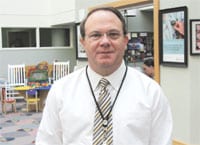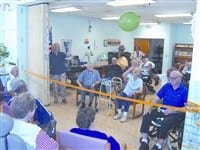Concession to Reality Shriners Hospital for Children Starts Accepting Payments
Bernadette White recalls the pleas from parents when Shriners Hospital for Children in Springfield was threatened with closure two years ago.
“They said, ‘we have insurance. Take my insurance — don’t close,’” said White, the hospital’s director of public relations. “In fact, over the years, a lot of families said they did not understand why we didn’t take insurance. They came for our expertise, not how it’s paid for.”
But that refusal to accept third-party payments, instead choosing to fund all care directly from its endowment, has long been one of the hallmarks of the Shriners organization, speaking to a culture where as many resources as possible were poured into patient care, not billing and overhead, said Mark Niederpruem, administrator of the Springfield facility.
“It’s one of the things that differentiated the organization,” he told HCN. “I think it kept the cost of care down, because there is anywhere from 25{06cf2b9696b159f874511d23dbc893eb1ac83014175ed30550cfff22781411e5} to 35{06cf2b9696b159f874511d23dbc893eb1ac83014175ed30550cfff22781411e5} in overhead related to sending bills out. So it was more money toward direct care versus administrative costs.”
Now, however, Shriners is making the very shift suggested by those parents during those anxious months in 2009, when the national Shriners organization, struggling with finances — the endowment took a major hit in the stock market in 2008, and costs were outpacing revenues by some $1 million per day — looked into closing the Springfield facility and five others around the country. Eventually all were allowed to remain open, with a major financial change.
“Two years ago, it was decided to have Shriners Hospitals in the U.S. begin to accept third-party payments, and since that time, all our sister hospitals have begun accepting pay; we began in April of this year,” Niederpruem said.
“The decision was made basically because of the financial situation of the hospital,” he continued. “For 85 years, we’ve been supported by our endowment, but escalating health care costs and the downturn in the economy collided and brought about a need to have a new revenue source, the most logical one being to accept insurance from those who have it.”
What families need to understand, Niederpruem said, is that the services offered at Shriners hospitals — all treat young people; Springfield’s facility has a special focus on orthopedic care, while others center on spinal-cord injuries, burns, and other niches — won’t change even as a very public aspect of the operation, its self-sustainence, goes by the wayside.
“We’ve been operating in a certain fashion for eight and a half decades, and how people perceive us is important,” he said. “But the underlying concept is that we have a great place to take kids who need specialized services, and we want to maintain that, regardless of the way services are paid for. You could say the hospital is more financially stable now.”
Step Forward
That’s important because Shriners competes with other health care providers, not as much in Greater Springfield, where its unique niche makes it an obvious choice for local families seeking orthopedic care, as across New England and New York, a wide swath of geography from which it draws patients.
Clearly, the financial stability of the parent organization is a plus, but charging for services has drawbacks, too, from the aforementioned administrative hassles to the government oversight that emerges when insurers are involved. “That’s not all bad, but it is an added cost that Shriners had been able to sidestep, even though we’re fully licensed and Joint Commission-approved,” Niederpruem said.
While Shriners Hospital in Springfield treats some 1,000 inpatients annually and logs about 20,000 outpatient visits per year, only about half its young patients hail from Massachusetts; the rest are referred from surrounding states and abroad — 31 countries in all last year.
As an orthopedic specialty hospital, the Springfield facility focuses on conditions ranging from scoliosis, cerebral palsy, and spina bifida to club foot, chest-wall deformities, cleft lip and palate, and a host of other conditions afflicting the limbs, joints, bones, and extremities.
The hospital is committed to using the most state-of-the-art equipment within its means. Take, for instance, a surgical treatment for cleft palate that employs computer-automated drafting (CAD) and computer-automated machinery (CAM) technology. It creates a 3D model of the palate to customize a series of devices that gradually reduce the size of the gap.
Or consider the hospital’s motion-analysis laboratory, where an array of infrared cameras examine how a child walks and converts that data to a 3D model that gives doctors all they need to know about a child’s progress — cutting-edge technology that originated in the movie and video-game industries.
Moving to a completely different financial structure has been, in many ways, just as impressive.
“We’ve had to put in place some very complex and challenging processes; the paperwork is immense and can be very confusing and formidable,” said Niederpruem, adding that Shriners has retained the services of PricewaterhouseCoopers to help roll out the new payment system in its 20 U.S. hospitals; the facilities in Canada and Mexico are unaffected.
“It has taken a year and a half to bring the third-party pay up to speed,” he said. “It’s taken a yeoman’s effort, and we’re just starting to see the effects of that work. One key element is having contracts for service, and that involved more than 260 insurance companies and the Medicaid programs in all 50 states.”
Shriners Hospital will continue to treat patients without insurance for free, and similar flexibility will accommodate families who can’t afford the co-pays and deductibles that are now required.
“A big factor with insurance companies is the need to accept co-pays and deductibles, but the Shriners had a bylaw that they wouldn’t take money from patients and families,” Niederpruem said, adding that the organization’s board had to vote to lift that ban.
“For those families for whom it becomes a burden, there will be mechanisms in place to help them,” he added. “Co-pays shouldn’t be a barrier, since it’s just $20 or $30, although when you’re coming a couple times a week, that can be a lot. But we’re seeing people with $5,000 deductible policies, and if they have to put that out, they won’t come. It’s catastrophic insurance that they’re buying, which is fine, but when they’re coming here periodically, it’s a burden on families. And we won’t refuse anyone because of that.”
In short, Niederpruem said, “we’ll continue to provide services free of charge to those who can’t afford it. We’re very proud of that legacy, and we want to continue that.”
Like Family
Considering that commitment, he said, the shift to accepting third-party payments and charging patients co-pays and deductibles hasn’t significantly changed the culture of Shriners Hospital.
“It probably has to some degree, but our staff is more conscious of it than anyone,” he told HCN. “There is an added layer, and a change in the way we do business, but I don’t think there has been a dramatic effect on the service-delivery component.”
In fact, the facility is busy extending its outreach efforts across New England, sending clinicians to various sites and planning to create a mobile unit, similar to a bloodmobile, to put another face on its services.
“Patients are with us from infancy to age 21, and they consider us family,” White said. “There’s a lot of affection out there toward Shriners Hospital.”
Whether they can afford to pay or not.



Comments are closed.